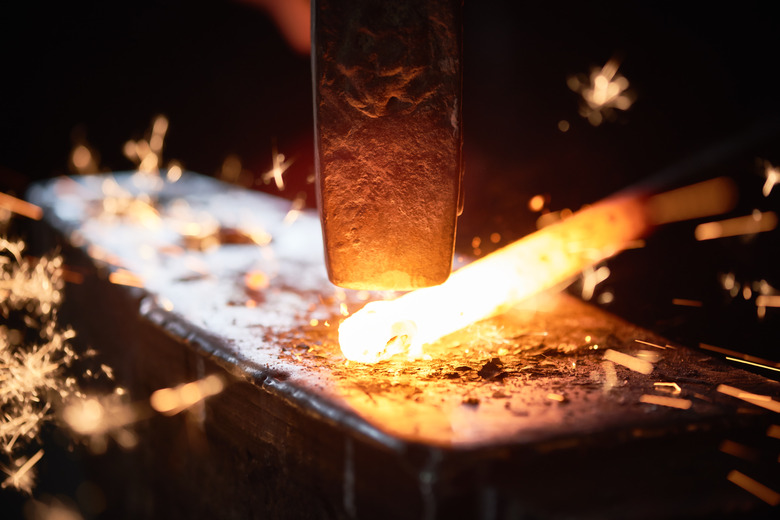Types Of Metal Hardening Processes
Metal is known for being a tough substance that can stand up to a lot of wear and tear, but it might not have started out that way. Many types of metals have gone through the process of metal hardening in order to make them better suited for the job they need to do. There are different types of hardening that, through complex processes of heating and cooling, help to make metals tough, durable and easy to work with.
TL;DR (Too Long; Didn't Read)
Each metal hardening process includes three main steps: heating, soaking and cooling the metal. Some common types of hardening include strain hardening, solid solution strengthening, precipitation hardening, and quenching and tempering.
Heat It Up
Heat It Up
While engineers and metal workers have come up with several different types of hardening depending on the type of metal and the results they want to see, each type involves three basic parts: heating the metal, soaking it and then cooling it.
During the first step, heat treatment, metal workers heat the material, often at extremely hot temperatures. Sometimes, they do this to change the the physical or chemical composition of the metal, often to make it easier to manipulate and work with. For instance, when some metals are exposed to temperatures higher than 1,000 degrees Fahrenheit, their internal structure changes. This can be temporary, so that metal workers can change its shape and then have it go back to its original state. In other metals, the change is permanent. Sometimes, that internal structure becomes stronger and tougher, making it a better material to be used in something that requires strength, like the construction of a skyscraper. Other times, heat treatment is used to increase the ductility of a metal. Metals with high levels of ductility are able to withstand forces pulling at them from either end. This is an important quality for metals like copper, which need to be pulled into thin strips of copper wire, or gold, which is often pulled into thin strands to make jewelry.
Soaking and Cooling
Soaking and Cooling
The second part of the process is soaking the metal. Although the word "soaking" might make you think of the way you would soak a dog in a bath after a run through a muddy backyard, soaking in the metal-hardening process is a little different. A metal isn't soaked in a tub full of a liquid substance. Instead, soaking in this instance refers to making sure that once the metal has hit the desired temperature during the heating process, it "soaks" in that heat. The timing is different for all the different types of hardening, but in general, a metal worker has to make sure that all of the pieces of metal reach the right temperatures for a specific amount of time.
The third and final step in the hardening process is cooling. After metal has been heated and allowed to soak in that heat, the metal must be cooled. Sometimes, metals revert back to their original chemical or physical structure after this process. Other times, metal workers make sure that the metals are altered for good.
Types of Metal Hardening
Types of Metal Hardening
There are several different types of processes for hardening metal, depending on the type of metal that workers start with and the material they want to turn it into.
One of the most common is Martensitic transformation, also known as quenching and tempering. It is a complex process to harden steel, and metal workers have to be careful to carry out each step correctly. First, they must heat the steel to an extreme temperature. Then, the crystal structure inside the steel changes to allow more carbon to be dissolved. At that point, the metal has to be quenched, or cooled, quickly enough so the carbon doesn't have time to form other unwanted materials in the metal. The quick cooling makes it stay in a hardened state, making it a stronger material better suited to withstand a lot of wear and tear. The different states it goes through during the process are called austenite and martensite, and an austempering and martempering resource can give you more information about the process.
Other types of hardening processes include case hardening, annealing and precipitation hardening. Each works in different ways to make metals more durable, ductile, tough or malleable in order to help engineers use them in a variety of ways. There are all kinds of metals in the world around you, and chances are, a metal worker used a hardening process to get them into the state they are in today.
Cite This Article
MLA
Dragani, Rachelle. "Types Of Metal Hardening Processes" sciencing.com, https://www.sciencing.com/info-8737494-types-metal-hardening-processes/. 26 November 2018.
APA
Dragani, Rachelle. (2018, November 26). Types Of Metal Hardening Processes. sciencing.com. Retrieved from https://www.sciencing.com/info-8737494-types-metal-hardening-processes/
Chicago
Dragani, Rachelle. Types Of Metal Hardening Processes last modified March 24, 2022. https://www.sciencing.com/info-8737494-types-metal-hardening-processes/
